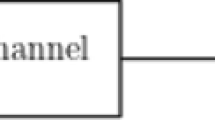Abstract
To achieve high precision with fewer storage resources, an improved Goldschmidt division method of using the mapping of divisors is presented. The improved division method does not need the initial approximation, which means that the look-up table can be saved. Then a mapping method is proposed to reduce the relative errors of the iteration results through multiplying the dividends and divisors by the mapping coefficients simultaneously. Since the mapping coefficients are all fixed factors, the mapping method applies CSD coding in the multiplication with fixed factors to reduce the hardware resources. Finally, using fewer hardware resources, the proposed method can achieve smaller relative errors.
Similar content being viewed by others
References
Flynn M J. On division by functional iteration. IEEE Trans Comput, 1970, C-19: 702–706
Gallagher W L, Swarzlander E E. Fault-tolerant Newton-Raphson and Goldschmidt dividers using time shared TMR. IEEE Trans Comput, 2000, 49: 588–595
Goldschmidt R E. Applications of Division by Convergence. MIT Press, 1964
Kong I, Swartzlander E E. A rounding method to reduce the required multiplier precision for Goldschmidt division. IEEE Trans Comput, 2010, 59: 1703–1708
Kong I, Swartzlander E E. A Goldschmidt division method with faster than quadratic. IEEE Trans Very Large Scale Integr (VLSI) Syst, 2011, 19: 696–700
Ercegovac M D, Matula D W. Improving Goldschmidt division, square root, and square root reciprocal. IEEE Trans Comput, 2000, 49: 759–763
Mahesh R, Vinod A P. A new common subexpression elimination algorithm for realizing low-complexity higher order digital filters. IEEE Trans Comput-Aided Des Integr Circuits Syst, 2008, 27: 217–229
Piso D, Bruguera J D. Variable latency Goldschmidt algorithm based on a new rounding method and a remainder estimate. IEEE Trans Comput, 2011, 60: 1535–1546
IEEE. IEEE Standard for Binary Floating-Point Arithmetic. IEEE Std754-2008. IEEE Computer Society, 2008
Xu F, Chang C H, Jong C C. Design of low-complexity FIR filters based on signed-powers-of-two coefficients with reusable common subexpressions. IEEE Trans Comput-Aided Des Integr Circuits Syst, 2007, 26: 1898–1907
Chang C H, Faust M. On a new common subexpression elimination algorithm for realizing low-complexity higher order digital filters. IEEE Trans Comput-Aided Des Integr Circuits Syst, 2010, 29: 844–848
Faust M, Gustafsson O, Chang C H. Fast and VLSI efficient binary-to-CSD encoder using bypass signal. Electron Lett, 2011, 47: 18–20
Author information
Authors and Affiliations
Corresponding author
Rights and permissions
About this article
Cite this article
Yan, W., Qu, X., Chen, H. et al. Improved Goldschmidt division method using mapping of divisors. Sci. China Inf. Sci. 56, 1–6 (2013). https://doi.org/10.1007/s11432-013-4996-1
Received:
Accepted:
Published:
Issue Date:
DOI: https://doi.org/10.1007/s11432-013-4996-1




